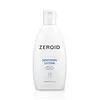What's inside
What's inside
 Key Ingredients
Key Ingredients

 Benefits
Benefits

 Concerns
Concerns

 Ingredients Side-by-side
Ingredients Side-by-side

Water
Skin ConditioningGlycerin
HumectantPropanediol
SolventCaprylic/Capric Triglyceride
MaskingCetearyl Alcohol
EmollientSorbitan Stearate
EmulsifyingCarthamus Tinctorius Seed Oil
MaskingGlyceryl Stearate
EmollientStearic Acid
CleansingMyristoyl/Palmitoyl Oxostearamide/Arachamide Mea
Skin ConditioningMethyl Caprooyl Tyrosinate
Skin ProtectingPhytosterols
Skin ConditioningTocopheryl Acetate
AntioxidantBisabolol
MaskingXanthan Gum
EmulsifyingSodium Hyaluronate
HumectantDimethicone
Emollient1,2-Hexanediol
Skin ConditioningCaprylyl Glycol
EmollientTropolone
Skin ConditioningWater, Glycerin, Propanediol, Caprylic/Capric Triglyceride, Cetearyl Alcohol, Sorbitan Stearate, Carthamus Tinctorius Seed Oil, Glyceryl Stearate, Stearic Acid, Myristoyl/Palmitoyl Oxostearamide/Arachamide Mea, Methyl Caprooyl Tyrosinate, Phytosterols, Tocopheryl Acetate, Bisabolol, Xanthan Gum, Sodium Hyaluronate, Dimethicone, 1,2-Hexanediol, Caprylyl Glycol, Tropolone
Water
Skin ConditioningButylene Glycol
HumectantGlycerin
HumectantDimethicone
EmollientSqualane
EmollientPentaerythrityl Tetraisostearate
EmollientBetaine
HumectantPolyglyceryl-3 Methylglucose Distearate
EmulsifyingButylene Glycol Dicaprylate/Dicaprate
EmollientCaprylic/Capric Triglyceride
MaskingPalmitic Acid
Emollient1,2-Hexanediol
Skin ConditioningStearic Acid
CleansingHydroxyethyl Acrylate/Sodium Acryloyldimethyl Taurate Copolymer
Emulsion StabilisingGlyceryl Stearate
EmollientHydroxypropyl Bispalmitamide Mea
EmollientGlyceryl Stearate Citrate
EmollientCholesterol
EmollientNiacinamide
SmoothingDimethiconol
EmollientHydroxypropyl Bislauramide Mea
EmollientBehenyl Alcohol
EmollientGlyceryl Caprylate
EmollientCarbomer
Emulsion StabilisingDisodium EDTA
Ethylhexylglycerin
Skin ConditioningTromethamine
BufferingSorbitan Isostearate
EmulsifyingPhytosphingosine
Skin ConditioningMannitol
HumectantCeramide NP
Skin ConditioningTocopherol
AntioxidantHydrogenated Lecithin
EmulsifyingAcrylates/Ammonium Methacrylate Copolymer
Silica
AbrasiveSphingolipids
EmollientArachidic Acid
CleansingOleic Acid
EmollientWater, Butylene Glycol, Glycerin, Dimethicone, Squalane, Pentaerythrityl Tetraisostearate, Betaine, Polyglyceryl-3 Methylglucose Distearate, Butylene Glycol Dicaprylate/Dicaprate, Caprylic/Capric Triglyceride, Palmitic Acid, 1,2-Hexanediol, Stearic Acid, Hydroxyethyl Acrylate/Sodium Acryloyldimethyl Taurate Copolymer, Glyceryl Stearate, Hydroxypropyl Bispalmitamide Mea, Glyceryl Stearate Citrate, Cholesterol, Niacinamide, Dimethiconol, Hydroxypropyl Bislauramide Mea, Behenyl Alcohol, Glyceryl Caprylate, Carbomer, Disodium EDTA, Ethylhexylglycerin, Tromethamine, Sorbitan Isostearate, Phytosphingosine, Mannitol, Ceramide NP, Tocopherol, Hydrogenated Lecithin, Acrylates/Ammonium Methacrylate Copolymer, Silica, Sphingolipids, Arachidic Acid, Oleic Acid
 Reviews
Reviews

Ingredients Explained
These ingredients are found in both products.
Ingredients higher up in an ingredient list are typically present in a larger amount.
1,2-Hexanediol is a synthetic liquid and another multi-functional powerhouse.
It is a:
- Humectant, drawing moisture into the skin
- Emollient, helping to soften skin
- Solvent, dispersing and stabilizing formulas
- Preservative booster, enhancing the antimicrobial activity of other preservatives
This ingredient is an emollient, solvent, and texture enhancer. It is considered a skin-softener by helping the skin prevent moisture loss.
It helps thicken a product's formula and makes it easier to spread by dissolving clumping compounds.
Caprylic Triglyceride is made by combining glycerin with coconut oil, forming a clear liquid.
While there is an assumption Caprylic Triglyceride can clog pores due to it being derived from coconut oil, there is no research supporting this.
Learn more about Caprylic/Capric TriglycerideDimethicone is a type of synthetic silicone created from natural materials such as quartz.
What it does:
Dimethicone comes in different viscosities:
Depending on the viscosity, dimethicone has different properties.
Ingredients lists don't always show which type is used, so we recommend reaching out to the brand if you have questions about the viscosity.
This ingredient is unlikely to cause irritation because it does not get absorbed into skin. However, people with silicone allergies should be careful about using this ingredient.
Note: Dimethicone may contribute to pilling. This is because it is not oil or water soluble, so pilling may occur when layered with products. When mixed with heavy oils in a formula, the outcome is also quite greasy.
Learn more about DimethiconeGlycerin is already naturally found in your skin. It helps moisturize and protect your skin.
A study from 2016 found glycerin to be more effective as a humectant than AHAs and hyaluronic acid.
As a humectant, it helps the skin stay hydrated by pulling moisture to your skin. The low molecular weight of glycerin allows it to pull moisture into the deeper layers of your skin.
Hydrated skin improves your skin barrier; Your skin barrier helps protect against irritants and bacteria.
Glycerin has also been found to have antimicrobial and antiviral properties. Due to these properties, glycerin is often used in wound and burn treatments.
In cosmetics, glycerin is usually derived from plants such as soybean or palm. However, it can also be sourced from animals, such as tallow or animal fat.
This ingredient is organic, colorless, odorless, and non-toxic.
Glycerin is the name for this ingredient in American English. British English uses Glycerol/Glycerine.
Learn more about GlycerinGlyceryl Stearate is a mix of glycerin and stearic acid.
It is used to stabilize the mixing of water and oil ingredients. By preventing these ingredients from separating, it can help elongate shelf life. It can also help thicken the product's texture.
As an emollient, it helps soften skin and supports barrier-replenishing ingredients.
In cosmetics, Glyceryl Stearate is often made from vegetable oils or synthetically produced.
This ingredient may not be fungal-acne safe
Fun fact: The human body also creates Glyceryl Stearate naturally.
Learn more about Glyceryl StearateStearic Acid is a fatty acid. It is an emollient, emulsifier, and texture enhancer.
As an emollient, stearic acid helps soften skin. It aids the skin's protective barrier by preventing water loss. It also provides a gentle cleansing effect without stripping away natural oils.
Stearic acid may also be used to enhance the texture of products. It can add volume and stabilize ingredients such as water and oil. This can help water and oil ingredients from separating.
Sources of stearic acid include animal or vegetable fats/oils such as coconut or shea. It can be naturally found in butter, cocoa butter, shea butter, vegetable fats, and animal tallow.
This ingredient may not be Malassezia folliculitis, or fungal-acne safe.
Learn more about Stearic AcidWater. It's the most common cosmetic ingredient of all. You'll usually see it at the top of ingredient lists, meaning that it makes up the largest part of the product.
So why is it so popular? Water most often acts as a solvent - this means that it helps dissolve other ingredients into the formulation.
You'll also recognize water as that liquid we all need to stay alive. If you see this, drink a glass of water. Stay hydrated!
Learn more about Water